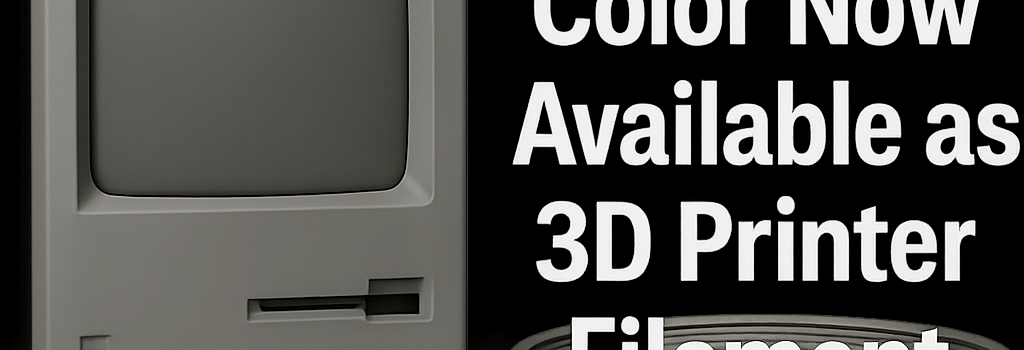Macintosh ‘Platinum’ Color Now Available as 3D-Printer Filament

On June 3, 2025, vintage computing enthusiast Joe Strosnider unveiled “Retro Platinum,” a polylactic acid (PLA) filament that faithfully replicates the iconic beige-gray “Platinum” hue used across Apple’s late-1980s and 1990s Macintosh lineup. By investing roughly $900 to develop a 25 kg production run, Strosnider and filament manufacturer Polar Filament have filled a critical gap for hobbyists restoring or customizing classic Mac hardware.
Background: The Rise and Fade of Platinum Plastic
First introduced on the Apple IIgs in 1986 and later featured on the Macintosh SE, SE/30, Classic, and Color Classic, the Platinum plastic scheme (Pantone 427 C–adjacent) defined an era. Over decades, UV exposure and heat have caused original ABS and SAN plastic bezels to yellow and embrittle, making matched replacement shells rare and inconsistent. Previous attempts at DIY color matching relied on small-batch spray paint or imported filament with “chalky” finishes and high shipping costs.
Technical Specifications of Retro Platinum PLA
- Material: 100% virgin PLA resin, biodegradable-grade
- Color Matching Technique: Spectrophotometer readings (L* = 80.3, a* = 0.2, b* = 3.5) from an internal speaker bezel sample
- Pigment Load: 6.5% proprietary titanium dioxide and calcium carbonate blend for UV stability
- Diameter: 1.75 mm ± 0.03 mm tolerance, compatible with direct-drive and Bowden extruders
- Recommended Printing Parameters: 190–210 °C nozzle temperature, 50–60 °C heated bed, 0.2 mm layer height
- Spool Size & Price: 1 kg spools at US $21.99/kg; bulk discounts available for orders >10 kg
Color Matching Methodology
Strosnider worked with Polar Filament’s materials engineers to scan an original Mac Color Classic speaker grille using a Konica Minolta CM-700d spectrophotometer. By capturing precise CIELAB data, they calibrated the colorants to match aged plastic—compensating for yellowing via subtractive color theory. The project showcases how modern color science can revive retro aesthetics with sub-another Delta E (<0.5) accuracy.
Material Properties and Printing Guidelines
PLA’s low glass transition temperature (~60 °C) and minimal warping are ideal for FDM/FFF desktop printers. However, experts recommend:
- Using a well-calibrated extruder to prevent diameter fluctuations.
- Optimizing fan speed at 50–70% to reduce stringing.
- Applying a thin PVA glue stick or PEI surface for improved first-layer adhesion.
For larger parts—such as full-size Macintosh SE shells—consider printing in micro-layers (0.12 mm) to minimize visible layer lines and enhance structural rigidity.
Community-Driven Innovation and Expert Insights
“The Retro Platinum filament is more than a color match—it’s a bridge between decades of hardware design and today’s digital fabrication techniques,” says Dr. Elena Martinez, a polymer chemist at the Additive Manufacturing Research Center. “By making the formula public, Strosnider democratizes restoration and sparks new creative workflows.”
Online communities on Tinkerdifferent, Reddit’s r/VintageComputing, and the Vintage Mac Facebook group have already shared custom case mods, keyboard keycaps, and even 3D-printed drive bezels, all using the new filament. Demand remains high: Polar Filament reported selling over 200 kg within the first week of release.
Environmental Impact and PLA Biodegradability
PLA is derived from renewable resources such as corn starch, and under industrial composting conditions (58 °C with > 50% humidity), it can biodegrade within 90 days. Polar Filament’s batch is certified industrially compostable under ASTM D6400 standards. While most hobbyists retain printed parts rather than compost them, the eco-friendly profile adds to the appeal of niche restoration projects.
Future Prospects: Beyond Macintosh Shells
The success of Retro Platinum has inspired collaborations between polarFilament and open-source hardware projects. Later this summer, a team at RetroWave is testing a custom ABS blend with the same color profile but enhanced impact strength—ideal for drop-resistant devices and functional enclosures.
Strosnider encourages the community to place recurring orders: “Let Polar know you want this shade in their catalog forever—continuous demand ensures ongoing production and formula refinement.”
Categories: Gadgets & Hardware, Tech News, Startups & Innovation